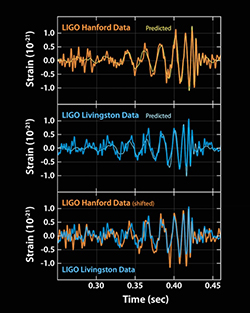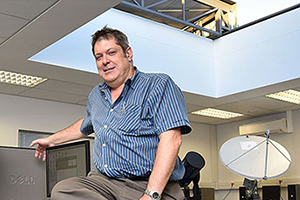
Profile of the gravitational waves of the colliding black holes. |
Prof Pieter Meintjes, Affiliated Researcher in the Department of Physics at the University of the Free State, welcomed the work done by the Laser Interferometer Gravitational-Wave Observatory (LIGO) science team.
For the first time, researchers from two of the American Ligo centres, in Washington and Louisiana respectively, observed gravitational waves directly, 100 years after Albert Einstein said they existed. "My study field in astrophysics involves relativistic systems. Therefore, Einstein's view of gravity is crucial to me. I consider the theory as the highest form of human creativity - just like the music of JS Bach. Over the past 100 years, the theory has been tested through various experiments and in different ways.
“The discovery of gravitational waves was the last hurdle to overcome in making this absolutely unfaltering. I am therefore thrilled by the discovery. It is absolutely astounding to imagine that the equations used to make the predictions about the gravitational-wave emissions when two gravitational whirlpools collide - as discovered on 14 September 2015 by LIGO - are basically Einstein's original equations that were published way back in 1916 - in other words, 100 years ago.
“The LIGO detectors have been operational since the early 1990s, but they had to undergo several stages of upgrades before being sensitive enough to make detections. LIGO is currently in its final stage, and is expected to function at optimal sensitivity only within a year or two. To be able to conduct the measurements at this stage is therefore a fantastic achievement, since much more funding will certainly be deposited in the project,” Prof Meintjes says.

Prof Pieter Meintjes
Photo: Charl Devenish |
The search for gravitational waves by means of the Square Kilometre Array (SKA) is one of the focus points in research by both Prof Meintjes and PhD student, Jacques Maritz. This involves the study of radio signals from pulsars that might show signs of effects by gravitational waves. They are looking for signs of gravitational waves. The gravitational waves discovered and studied in this manner would naturally vary much more slowly than the signal discovered from the two colliding gravitational waves.
The discovery will definitely provide renewed impetus to the Square Kilometre Array (SKA) Project to use the dispersion of pulsar signals, and to search for the impact of gravitational waves on signals as they travel through the universe. According to Prof Meintjes, the SKA will definitely contribute fundamentally to the Frontier research, which will provide a good deal of publicity for the UFS and South Africa, if significant contributions are made by local researchers in this field.
Video clip explaining gravitational waves
- The Department of Physics will present a general, non-technical talk concerning the recent detection of gravitational waves by the 2 Laser Interferometer Gravitational Wave Observatories (LIGO):
Wednesday 24 February 2016
11:00-12:00
New lecture auditorium, Department of Physics